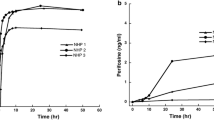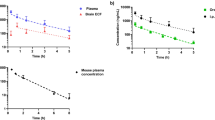Summary
Equimolar doses of chlorambucil and melphalan (both 10 mg/kg) were administered i.v. to anesthetized rats, and the plasma and brain concentrations of chlorambucil, its metabolites 3,4-dehydrochlorambucil and phenylacetic mustard, and melphalan were determined by high-performance liquid chromatography from 5 to 240 min therafter. Chlorambucil demonstrated a monophasic disappearance from plasma, with a half-life of 26 min. The compound was 99.6% plasma-protein-bound. Chlorambucil underwent β-oxidation to yield detectable concentrations of 3,4-dehydrochlorambucil and substantial amounts of phenylacetic mustard in the plasma. Low concentrations of chlorambucil and phenylacetic mustard were detected in the brain. Calculated from the areas under the concentration-time curves, the brain: plasma concentration integral ratios of chlorambucil and phenylacetic mustard were 0.021 and 0.013, respectively. Melphalan demonstrated a biphasic disappearance from plasma, with half-lives of 1.9 and 78 min. The compound was approximately 86% plasma protein-bound. Low concentrations of melphalan were detected in the brain, and its brain: plasma ratio was 0.13. These data demonstrate that following the administration of chlorambucil and melphalan, only low concentrations of active drug are able to enter the brain. As a consequence, concentrations of both drugs that cause the complete inhibition of extracerebrally located tumor have no effect on those located within the brain. Further, the brain uptake of melphalan, although low, is greater than that of chlorambucil and its active metabolites, which coincides with its slightly greater intracerebral activity following the systemic administration of very high doses.
Similar content being viewed by others
References
Adair C, McElnay J (1986) Studies on the mechanism of gastrointestinal absorption of melphalan and chlorambucil. Cancer Chemother Pharmacol 17: 95–98
Alberts D, Chang S, Chen S, Moon T, Evans T, Furner R, Himmelstein J (1979) Kinetics of intravenous melphalan. Clin Pharmacol Ther 26: 73–80
Begleiter A, Lam H, Grover J, Froese E, Goldenberg G (1979) Evidence for active transport of melphalan by amino acid carriers in L5178Y lymphoblasts in vitro. Cancer Res 39: 353–359
Bosanquet A, Gilbey E (1982) Pharmacokinetics of oral and intravenous melphalan during routine treatment of multiple myeloma. Eur J Cancer Clin Oncol 18: 355–362
Bosanquet A, Gilbey E (1984) Comparison of fed and fasting states on the absorption of melphalan in multiple myeloma. Cancer Chemother Pharmacol 12: 183–186
Byrne T, Moseley T, Finer M (1981) Myoclonic seizures following chlorambucil overdose. Ann Neurol 9: 191–194
Chirigos M, Mead J (1964) Experiments on determination of melphalan by fluorescence. Interaction protein and various solutions. Anal Biochem 7: 259–268
Cornbleet M, Leonard R, Smyth J (1984) High-dose agent therapy: A review of clinical experiences. Cancer Drug Deliv 1: 227–238
Dorr R, Fritz W (1980) Cancer chemotherapy handbook. Kimpton, London
Enck R, Bennett J (1977) Inadvertent chlorambucil overdose in adult. NY State J Med 77: 1480–1481
Ehrsson H, Lonroth U, Wallin I, Ehrnebo M, Nilsson S (1981) Degradation of chlorambucil in aqueous solution — influence of human albumin binding. J Pharm Pharmacol 33: 313–315
Ehrsson T, Lonroth U (1982) Degradation of melphalan in aqueous solutions — influence of human albumin binding. J Pharm Sci 71: 826–828
Fasman G (1976) CRC Handbook of biochemistry and molecular biology, 3rd edn, vol 1. CRC Press, Cleveland, p 319
Fisher B, Carbone P, Economons S (1975) L-Phenylalanine mustard in the management of primary breast cancer. N Engl J Med 292: 117–122
George R, Doth J, Duncan G (1977) Multiple myeloma intermittent combination chemotherapy compared to continuous therapy. Cancer 29: 1665–1670
Godeneche D, Madelmont J, Sauvezie B, Billaud A (1975) Etude de la cinetique d'absorption, de distribution et d'elimination de l'acide N,N-dichloro-2-ethyl-p-amino-phenyl-4, butyrique (chloraminophene) marque au 14C chez le rat. Biochem Pharmacol 24: 1303–1308
Godeneche D, Madelmont J, Moreau M, Plagne R, Meyniel G (1980) Comparative physico-chemical properties, biological effects, and disposition in mice of four nitrogen mustards. Cancer Chemother Pharmacol 5: 1–9
Goldenberg G, Lam H, Begleiter A (1979) Active carrier-mediated transport of melphalan by two separate amino acid transport systems in LPC-1 plasmacytoma cells in vitro. J Biol Chem 254: 1057–1064
Goodman G, Mclean A, Alberts D, Chang S (1982) Inhibition of human tumor clonogenicity by chlorambucil and its metabolites. Br J Cancer 45: 621
Green A, Naiman J (1968) Chlorambucil poisoning. Am J Dis Child 116: 190–191
Greig N (1984) Chemotherapy of brain metastases: current status. Cancer Treat Rev 11: 157–186
Greig N (1987) Brain tumors and the blood-tumor barrier. In: Neuwelt E (ed) The clinical impact of the blood-brain barrier and its manipulation, vol 2. Plenum, New York
Greig N (1987) Optimizing drug delivery to brain tumors. Cancer Treat Rev 14: 1–28
Greig N, Sweeney D (1987) Drug delivery to the brain by blood-brain barrier circumvention and drug modification. In: Neuwelt E (ed) The clinical impact of the blood-brain barrier and its manipulation, vol 1. Plenum, New York
Greig N, Momma S, Sweeney D, Smith Q, Rapoport S (1987) Facilitated transport of melphalan at the rat blood-brain barrier by the large neutral amino acid carrier system. Cancer Res 47: 1571–1576
Greig N, Sweeney D, Rapoport S (1987) Melphalan concentration dependent plasma protein binding in healthy humans and rats. Eur J Clin Pharmacol 32: 179–185
Hill B (1972) Studies on the transport and cellular distribution of chlorambucil in the Yoshida ascites sarcoma. Biochem Pharmacol 21: 495–502
Hill B, Riches P (1971) The absorption, distribution and excretion of 3H-chlorambucil in rats bearing Yoshida ascites sarcoma. Br J Cancer 15: 831–836
Idestrom K, Kimbey E, Bjorkholm M, Mellstedt H, Wahlby S (1982) Treatment of chronic lymphocytic leukaemia and well differentiated lymphoma with continuous low- or intermittent high-dose prednimustine versus chlorambucil prednisolone. Eur J Clin Oncol 18: 1117
Johnstone R, Scholefield P (1965) Amino acid transport into tumor cells. Adv Cancer Res 9: 143–226
Knott G (1979) M-LAB, a mathematical modeling tool. Comput Prog Biomed 10: 271–280
Marquardt D (1963) An algorithm for least squares estimation of nonlinear parameters. J Soc Ind Appl Math 11: 431–441
Martin B (1965) Potential effect of the plasma protein on drug distribution. Nature 207: 274–276
Martin A, Beer R, Bosanquet A, Gilbey E (1982) The effect of alkylating agents and other drugs on the accumulation of melphalan by murine L1210 leukemia cells in vitro. Biochem Pharmacol 31: 2727–2732
McLean A, Newell D, Baker G (1976) The metabolism of chlorambucil. Biochem Pharmacol 23: 2331
McLean A, Woods R, Catovsky D, Farmer P (1979) Pharmacokinetics and metabolism of chlorambucil in patients with malignant disease. Cancer Treat Rev 6 [Suppl]: 33–42
Miller R (1966) Simultaneous statistical inference. McGraw-Hill, New York, pp 76–81
Mitoma C, Onodera T, Takegoshi T, Thomas D (1977) Metabolic disposition of chlorambucil in rats. Xenobiotica 7: 205–220
Neame K (1968) A comparison of the transport systems for amino acids in brain, intestine, kidney and tumour. Prog Brain Res 29: 185–196
Newell D, Hart L, Harap K (1979) Estimation of chlorambucil, phenylacetic mustard and prednimustine in human plasma by high-performance liquid chromatography. J Chromatogr 164: 114
Oxender D, Christensen H (1963) Distinct mediating systems for the transport of neutral amino acids by the Ehrlich cell. J Biol Chem 28: 3686–3699
Piver M, Barlow J, Lee F (1975) Sequential therapy for advanced ovarian adenocarcinoma: operation, chemotherapy, second-look laparotomy and radiation therapy. Am J Obstet Gynecol 122: 355–357
Rapoport S (1976) Blood-brain barrier in physiology and medicine. Raven, New York
Rosin R, Westbury G (1980) Isolated limb perfusion for malignant melanoma. Practitioner 224: 1031–1036
Sawitsky A, Rai K, Glidewell O, Silver R (1977) Comparison of daily versus intermittent chlorambucil and prenisone therapy in the treatment of patients with chronic lymphocytic leukaemia. Blood50: 1049
Sweeney D, Greig N, Rapoport S (1985) High-performance liquid chromatography analysis of melphalan in plasma, brain and peripheral tissues by o-phthaladehyde derivatization and fluorescence detection. J Chromatogr 339: 434–439
Thomas E, Christensen H (1971) Nature of the cosubstrate action of Na+ and neutral amino acids in a transport system. J Biol Chem 246: 1682–1688
Vistica D (1983) Cellular pharmacokinetics of the phenylalanine mustards. Pharmacol Ther 22: 379–405
Vistica D, Toal J, Rabinovitz M (1978) Characterization of melphalan transport and correlation of uptake with cytotoxicity in cultured L1210 murine leukemia cells. Biochem Pharmacol 27: 2865–2870
Wade L, Katzman R (1975) Synthetic amino acids and the nature of L-DOPA transport at the blood-brain barrier. J Neurochem 25: 837–842
Wolfson S, Olney M (1957) Accidental ingestion of a toxic dose of chlorambucil. J Am Med Assoc 165: 239–240
Author information
Authors and Affiliations
Rights and permissions
About this article
Cite this article
Greig, N.H., Sweeney, D.J. & Rapoport, S.I. Comparative brain and plasma pharmacokinetics and anticancer activities of chlorambucil and melphalan in the rat. Cancer Chemother. Pharmacol. 21, 1–8 (1988). https://doi.org/10.1007/BF00262729
Received:
Accepted:
Issue Date:
DOI: https://doi.org/10.1007/BF00262729




